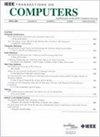Accelerating Loss Recovery for Content Delivery Network
IF 3.8
2区 计算机科学
Q2 COMPUTER SCIENCE, HARDWARE & ARCHITECTURE
引用次数: 0
Abstract
Packet losses significantly impact the user experience of content delivery network (CDN) services such as live streaming and data backup-and-archiving. However, our production network measurement studies show that the legacy loss recovery is far from satisfactory due to the wide-area loss characteristics (i.e., dynamics and burstiness) in the wild. In this paper, we propose a sender-side Adaptive ReTransmission scheme, ART, which minimizes the recovery time of lost packets with minimal redundancy cost. Distinguishing itself from forward-error-correction (FEC), which preemptively sends redundant data packets to prevent loss, ART functions as an automatic-repeat-request (ARQ) scheme. It applies redundancy specifically to lost packets instead of unlost packets, thereby addressing the characteristic patterns of wide-area losses in real-world scenarios. We implement ART upon QUIC protocol and evaluate it via both trace-driven emulation and real-world deployment. The results show that ART reduces up to 34% of flow completion time (FCT) for delay-sensitive transmissions, improves up to 26% of goodput for throughput-intensive transmissions, reduces 11.6% video playback rebuffering, and saves up to 90% of redundancy cost.加速内容交付网络的损失恢复
包丢失会严重影响内容交付网络(CDN)服务的用户体验,例如实时流媒体和数据备份和归档。然而,我们的生产网络测量研究表明,由于野外广域损失特征(即动态性和突发性),遗留损失的恢复远远不能令人满意。在本文中,我们提出了一种发送端自适应重传方案ART,该方案以最小的冗余代价最小化丢失数据包的恢复时间。与预先发送冗余数据包以防止丢失的前向纠错(FEC)不同,ART是一种自动重复请求(ARQ)方案。它专门将冗余应用于丢失的数据包,而不是未丢失的数据包,从而解决了现实场景中广域丢失的特征模式。我们在QUIC协议上实现ART,并通过跟踪驱动仿真和实际部署对其进行评估。结果表明,对于延迟敏感型传输,ART可减少高达34%的流完成时间(FCT),对于吞吐量密集型传输,可提高高达26%的goodput,减少11.6%的视频回放再缓冲,并节省高达90%的冗余成本。
本文章由计算机程序翻译,如有差异,请以英文原文为准。
求助全文
约1分钟内获得全文
求助全文
来源期刊

IEEE Transactions on Computers
工程技术-工程:电子与电气
CiteScore
6.60
自引率
5.40%
发文量
199
审稿时长
6.0 months
期刊介绍:
The IEEE Transactions on Computers is a monthly publication with a wide distribution to researchers, developers, technical managers, and educators in the computer field. It publishes papers on research in areas of current interest to the readers. These areas include, but are not limited to, the following: a) computer organizations and architectures; b) operating systems, software systems, and communication protocols; c) real-time systems and embedded systems; d) digital devices, computer components, and interconnection networks; e) specification, design, prototyping, and testing methods and tools; f) performance, fault tolerance, reliability, security, and testability; g) case studies and experimental and theoretical evaluations; and h) new and important applications and trends.
 求助内容:
求助内容: 应助结果提醒方式:
应助结果提醒方式:


